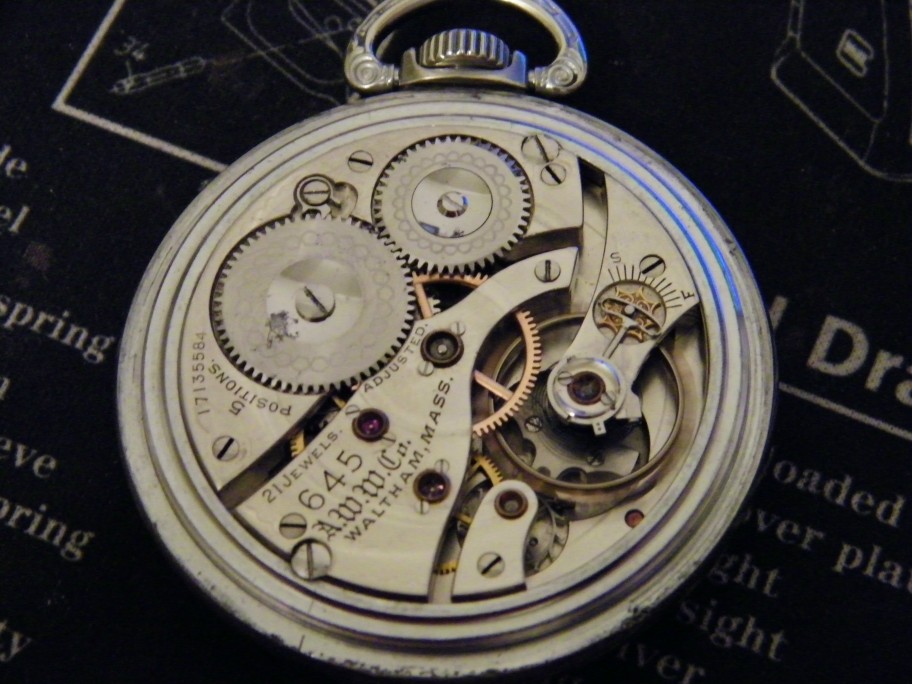
| WWT Shows | CLICK TO: Join and Support Internet Horology Club 185™ | IHC185™ Forums |

|
• Check Out Our... • • TWO Book Offer! • |
Welcome Aboard IHC185™  Internet Horology Club 185
Internet Horology Club 185  IHC185™ Discussion Site Main Page
IHC185™ Discussion Site Main Page  Horological Discussions, Questions and Answers
Horological Discussions, Questions and Answers  Pocket Watch Discussions
Pocket Watch Discussions  Railroad Watches - Case, Dial, Hand Criteria
Railroad Watches - Case, Dial, Hand Criteria
 Internet Horology Club 185
Internet Horology Club 185  IHC185™ Discussion Site Main Page
IHC185™ Discussion Site Main Page  Horological Discussions, Questions and Answers
Horological Discussions, Questions and Answers  Pocket Watch Discussions
Pocket Watch Discussions  Railroad Watches - Case, Dial, Hand Criteria
Railroad Watches - Case, Dial, Hand CriteriaGo  | New Topic  | Find-Or-Search  | Notify  | Tools  | Reply to Post  |  |
As you all are aware, I know very little about railroad watches. After seeing two Waltham model 645's up for sale by David Abbe, I remembered that I have one, too. Mine is in a "railroad style" Keystone base metal case, movement # 17135584, 21 jewel, adjusted. I don't know if it is period correct. I got to thinking about how Hamilton's have very specific case/dial/hand criteria by model and manufacture date. There are numerous posts about the subject. I am sure that other watch companies had the same type criteria for their railroad grade/approved watch models. And collectors of these watches know what to look for. My question is....why was it, and still is, so important that a particular railroad model have a specific set of dial/case/hands? I have read the watch guide railroad section and many posts here and I don't know who, why or when these requirements were made. The 1893 Railroad Timepiece Standards Commission rules didn't state that the bow had to be this style, the dial had to be double sunk, etc. Was it used as a signature of sorts for each model? I haven't come across this information yet that really spells it out. All thoughts and comments are welcome. Here is my model 645  | |||
|
and the movement....  | ||||
|
| IHC Life Member |
Mary Anne, you have several questions, so first I post below the first of 2 Waltham Railroad Ads that states unequivocaly that Waltham sells RR movements, and the Cases are sold by the Jobber/Jeweler.  | |||
|
| IHC Life Member |
To that end the next page (below) shows the 645 movement in the top middle sold as a movement only. In your case (pun intended), I think your whole watch, case included, could be considered "original". "Period Correctness" of a watch case that may be the sc eond, third or fourth replacement case was of little meaning unless you have a "mint" model that was never used. These were fine RR watches with Jeweled Motor Barrels that gave best time service for the money. That is why I refer to them as "Purpose Built" railroad watches. The "signed" RR cases sold with Hamiltons and some Elgins would have a "period" to them, and that I will leave to the experts to explain.  | |||
|
David, thank you for the ad pictures and your thoughts about my 645. I do appreciate it. Yes, you are right. The movements were shipped from the factory and the retailer had a selection of cases for the customer to choose from. I didn't phrase my question right, though. Why do we now place a premium on certain model/case/dial/hand combinations and when did this become important? How did this develop? Sorry...I sometimes have trouble finding the right words to convey my thoughts. | ||||
|
| IHC Life Member |
For example, "this old watch" that rolled into my stable for well under $100.00, turns out to be an early Hamilton 940, c.a. 1900 (s/n 124563 If I was playing cards that is a heckuva hand!). There is no doubt in my mind that the case is on its "third ride", the hands have probably been replaced by a Jeweler a few times in the last 109 years, and the dial should have! But the jeweler used the hard wax repair instead. Does that make this ecstatically beautiful and perfectly running movement any less "correct"? Heck no! After the joy of cleaning and reviving this beauty, I wish it could talk, that's all.  | |||
|
| Powered by Social Strata |
| Your request is being processed... |
|
Welcome Aboard IHC185™  Internet Horology Club 185
Internet Horology Club 185  IHC185™ Discussion Site Main Page
IHC185™ Discussion Site Main Page  Horological Discussions, Questions and Answers
Horological Discussions, Questions and Answers  Pocket Watch Discussions
Pocket Watch Discussions  Railroad Watches - Case, Dial, Hand Criteria
Railroad Watches - Case, Dial, Hand Criteria
 Internet Horology Club 185
Internet Horology Club 185  IHC185™ Discussion Site Main Page
IHC185™ Discussion Site Main Page  Horological Discussions, Questions and Answers
Horological Discussions, Questions and Answers  Pocket Watch Discussions
Pocket Watch Discussions  Railroad Watches - Case, Dial, Hand Criteria
Railroad Watches - Case, Dial, Hand Criteria©2002-2025 Internet Horology Club 185™ - Lindell V. Riddle President - All Rights Reserved Worldwide

